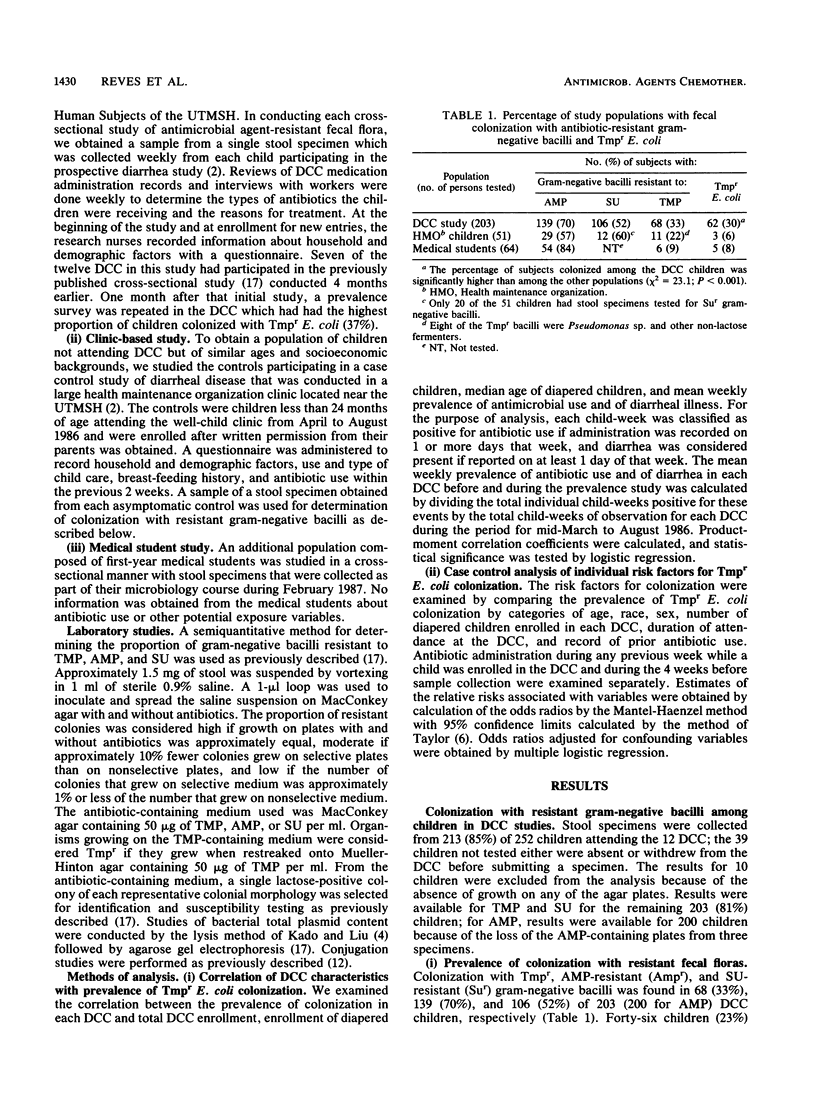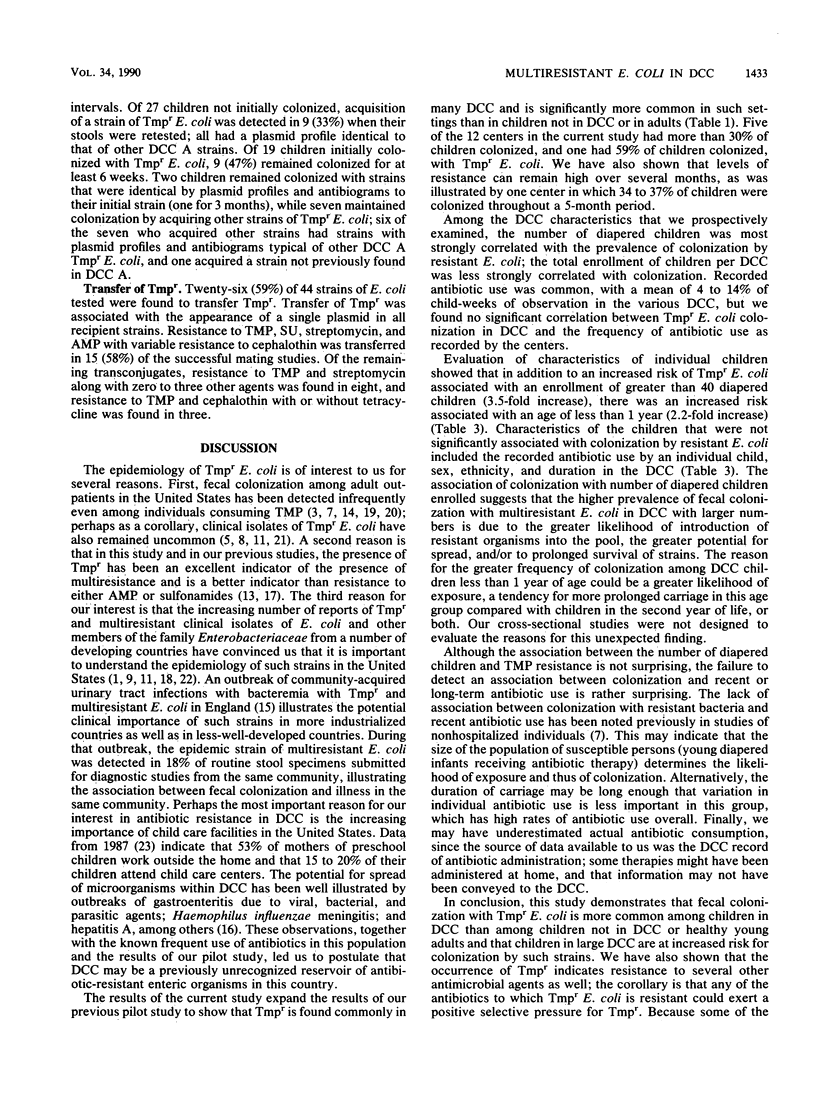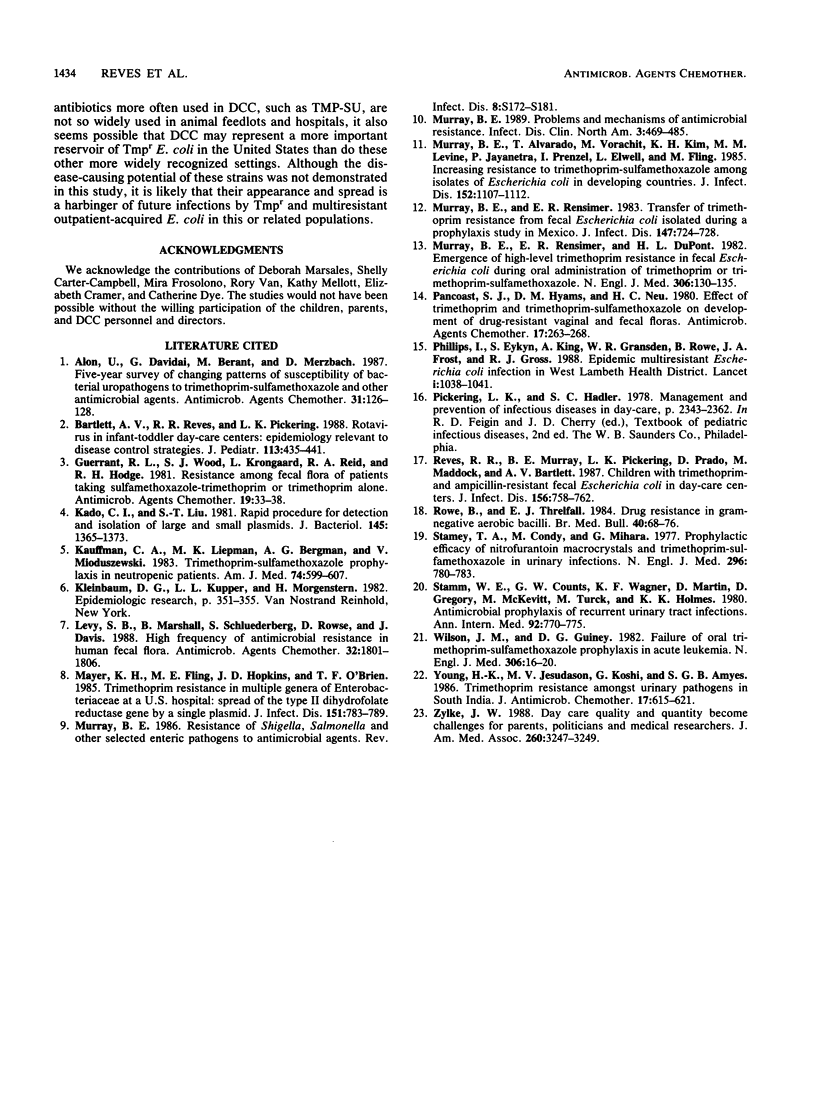Abstract
In a previous study, we found fecal colonization with multiresistant Escherichia coli exhibiting high-level trimethoprim resistance in 19% of diapered children attending six day-care centers in Houston, Tex. To examine the potential risk factors associated with this finding, we conducted cross-sectional studies among 203 children attending 12 day-care centers, 51 children attending a well-child clinic (controls), and 64 medical students. The prevalence of fecal colonization with trimethoprim-resistant E. coli among children attending day-care centers (30%) was higher (P less than 0.001) than among control children (6%) or medical students (8%). The prevalence of colonization among the children attending the 12 centers ranged from 0 to 59% and was correlated with the number of diapered children enrolled (r = 0.73; P less than 0.01). In a case control study among the day-care center children, significant risk factors were an age of less than 12 months and attendance at a center with an enrollment of over 40 diapered children (odds ratios of 2.2 and 3.5, respectively); ethnicity, duration of attendance, and prior antibiotic administration were not associated with colonization. Plasmid analysis of 60 of the day-care center strains revealed 22 profiles, each of which was unique to a given day-care center. Transmission and carriage of trimethoprim-resistant strains for as long as 6 months was documented in one center studied on three occasions. Given the documented transmission of enteric pathogens among diapered children attending day-care centers and their spread into family members, it is likely that day-care centers are an important community reservoir of plasmid-associated antibiotic-resistant E. coli.
Full text
PDF





Selected References
These references are in PubMed. This may not be the complete list of references from this article.
- Alon U., Davidai G., Berant M., Merzbach D. Five-year survey of changing patterns of susceptibility of bacterial uropathogens to trimethoprim-sulfamethoxazole and other antimicrobial agents. Antimicrob Agents Chemother. 1987 Jan;31(1):126–128. doi: 10.1128/aac.31.1.126. [DOI] [PMC free article] [PubMed] [Google Scholar]
- Bartlett A. V., 3rd, Reves R. R., Pickering L. K. Rotavirus in infant-toddler day care centers: epidemiology relevant to disease control strategies. J Pediatr. 1988 Sep;113(3):435–441. doi: 10.1016/S0022-3476(88)80624-3. [DOI] [PMC free article] [PubMed] [Google Scholar]
- Guerrant R. L., Wood S. J., Krongaard L., Reid R. A., Hodge R. H. Resistance among fecal flora of patients taking sulfamethoxazole-trimethoprim or trimethoprim alone. Antimicrob Agents Chemother. 1981 Jan;19(1):33–38. doi: 10.1128/aac.19.1.33. [DOI] [PMC free article] [PubMed] [Google Scholar]
- Kado C. I., Liu S. T. Rapid procedure for detection and isolation of large and small plasmids. J Bacteriol. 1981 Mar;145(3):1365–1373. doi: 10.1128/jb.145.3.1365-1373.1981. [DOI] [PMC free article] [PubMed] [Google Scholar]
- Kauffman C. A., Liepman M. K., Bergman A. G., Mioduszewski J. Trimethoprim/sulfamethoxazole prophylaxis in neutropenic patients. Reduction of infections and effect on bacterial and fungal flora. Am J Med. 1983 Apr;74(4):599–607. doi: 10.1016/0002-9343(83)91017-3. [DOI] [PubMed] [Google Scholar]
- Korzeniowski O. M. Effects of antibiotics on the mammalian immune system. Infect Dis Clin North Am. 1989 Sep;3(3):469–478. [PubMed] [Google Scholar]
- Levy S. B., Marshall B., Schluederberg S., Rowse D., Davis J. High frequency of antimicrobial resistance in human fecal flora. Antimicrob Agents Chemother. 1988 Dec;32(12):1801–1806. doi: 10.1128/aac.32.12.1801. [DOI] [PMC free article] [PubMed] [Google Scholar]
- Mayer K. H., Fling M. E., Hopkins J. D., O'Brien T. F. Trimethoprim resistance in multiple genera of Enterobacteriaceae at a U.S. hospital: spread of the type II dihydrofolate reductase gene by a single plasmid. J Infect Dis. 1985 May;151(5):783–789. doi: 10.1093/infdis/151.5.783. [DOI] [PubMed] [Google Scholar]
- Murray B. E., Alvarado T., Kim K. H., Vorachit M., Jayanetra P., Levine M. M., Prenzel I., Fling M., Elwell L., McCracken G. H. Increasing resistance to trimethoprim-sulfamethoxazole among isolates of Escherichia coli in developing countries. J Infect Dis. 1985 Dec;152(6):1107–1113. doi: 10.1093/infdis/152.6.1107. [DOI] [PubMed] [Google Scholar]
- Murray B. E., Rensimer E. R., DuPont H. L. Emergence of high-level trimethoprim resistance in fecal Escherichia coli during oral administration of trimethoprim or trimethoprim--sulfamethoxazole. N Engl J Med. 1982 Jan 21;306(3):130–135. doi: 10.1056/NEJM198201213060302. [DOI] [PubMed] [Google Scholar]
- Murray B. E., Rensimer E. R. Transfer of trimethoprim resistance from fecal Escherichia coli isolated during a prophylaxis study in Mexico. J Infect Dis. 1983 Apr;147(4):724–728. doi: 10.1093/infdis/147.4.724. [DOI] [PubMed] [Google Scholar]
- Murray B. E. Resistance of Shigella, Salmonella, and other selected enteric pathogens to antimicrobial agents. Rev Infect Dis. 1986 May-Jun;8 (Suppl 2):S172–S181. doi: 10.1093/clinids/8.supplement_2.s172. [DOI] [PubMed] [Google Scholar]
- Pancoast S. J., Hyams D. M., Neu H. C. Effect of trimethoprim and trimethoprim-sulfamethoxazole on development of drug-resistant vaginal and fecal floras. Antimicrob Agents Chemother. 1980 Feb;17(2):263–268. doi: 10.1128/aac.17.2.263. [DOI] [PMC free article] [PubMed] [Google Scholar]
- Phillips I., Eykyn S., King A., Gransden W. R., Rowe B., Frost J. A., Gross R. J. Epidemic multiresistant Escherichia coli infection in West Lambeth Health District. Lancet. 1988 May 7;1(8593):1038–1041. doi: 10.1016/s0140-6736(88)91853-3. [DOI] [PubMed] [Google Scholar]
- Reves R. R., Murray B. E., Pickering L. K., Prado D., Maddock M., Bartlett A. V., 3rd Children with trimethoprim- and ampicillin-resistant fecal Escherichia coli in day care centers. J Infect Dis. 1987 Nov;156(5):758–762. doi: 10.1093/infdis/156.5.758. [DOI] [PubMed] [Google Scholar]
- Rowe B., Threlfall E. J. Drug resistance in gram-negative aerobic bacilli. Br Med Bull. 1984 Jan;40(1):68–76. doi: 10.1093/oxfordjournals.bmb.a071950. [DOI] [PubMed] [Google Scholar]
- Stamey T. A., Condy M., Mihara G. Prophylactic efficacy of nitrofurantoin macrocrystals and trimethoprim-sulfamethoxazole in urinary infections. Biologic effects on the vaginal and rectal flora. N Engl J Med. 1977 Apr 7;296(14):780–783. doi: 10.1056/NEJM197704072961403. [DOI] [PubMed] [Google Scholar]
- Stamm W. E., Counts G. W., Wagner K. F., Martin D., Gregory D., McKevitt M., Turck M., Holmes K. K. Antimicrobial prophylaxis of recurrent urinary tract infections: a double-blind, placebo-controlled trial. Ann Intern Med. 1980 Jun;92(6):770–775. doi: 10.7326/0003-4819-92-6-770. [DOI] [PubMed] [Google Scholar]
- Wilson J. M., Guiney D. G. Failure of oral trimethoprim-sulfamethoxazole prophylaxis in acute leukemia: isolation of resistant plasmids from strains of Enterobacteriaceae causing bacteremia. N Engl J Med. 1982 Jan 7;306(1):16–20. doi: 10.1056/NEJM198201073060105. [DOI] [PubMed] [Google Scholar]
- Young H. K., Jesudason M. V., Koshi G., Amyes S. G. Trimethoprim resistance amongst urinary pathogens in south India. J Antimicrob Chemother. 1986 May;17(5):615–621. doi: 10.1093/jac/17.5.615. [DOI] [PubMed] [Google Scholar]
- Zylke J. W. Day-care quality and quantity become challenges for parents, politicians, and medical researchers. JAMA. 1988 Dec 9;260(22):3247–3249. [PubMed] [Google Scholar]


